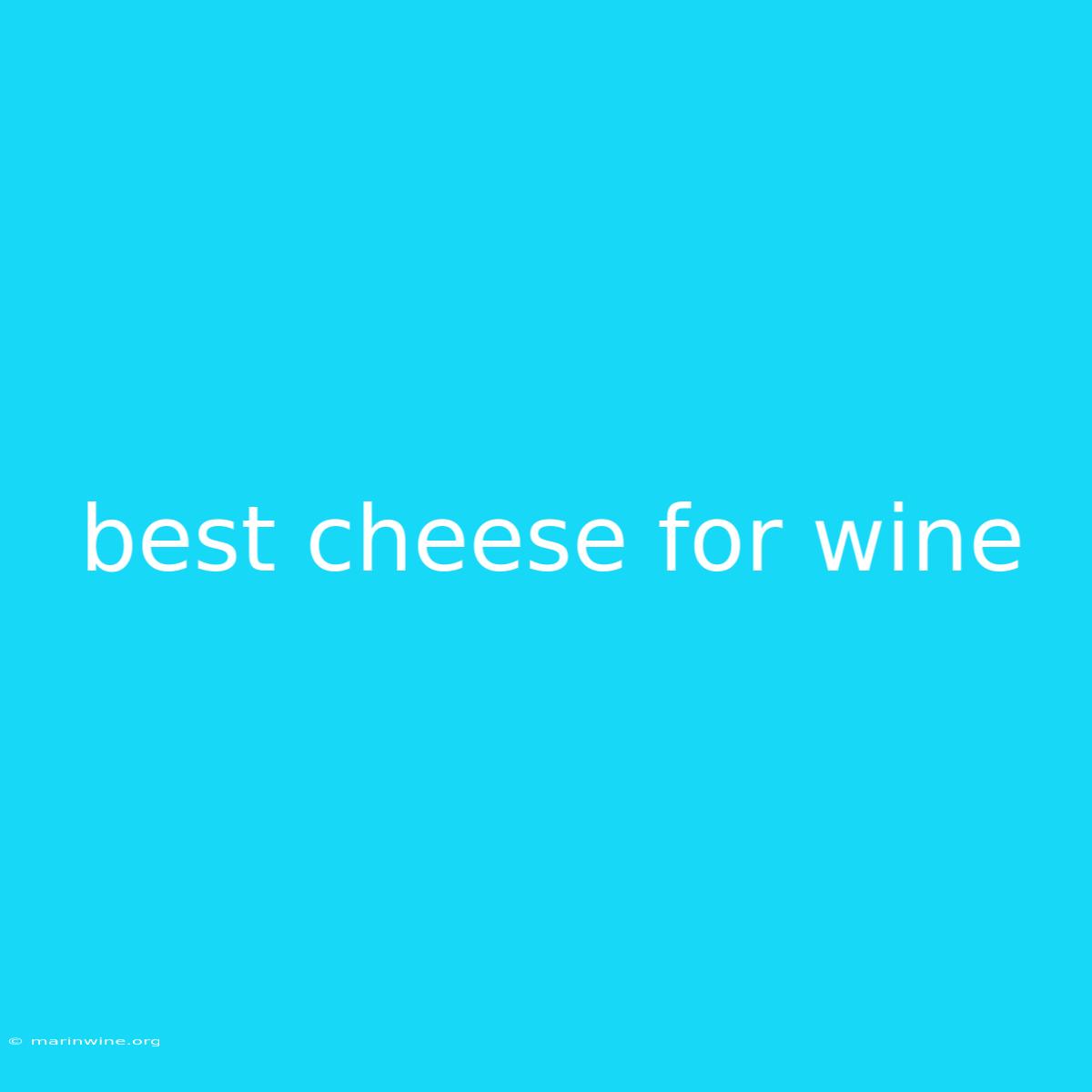The Perfect Pairing: Finding the Best Cheese for Wine
Have you ever wondered why some cheese and wine combinations just sing, while others clash like a bad symphony? The perfect pairing is more than just a matter of taste; it's a harmonious dance of flavor, texture, and aroma. This guide will take you on a journey through the world of cheese and wine, revealing the secrets to creating a truly unforgettable experience.
Why It Matters: Understanding the nuances of cheese and wine pairing can elevate your next gathering or simply enhance your personal enjoyment. Exploring these pairings allows you to discover new flavors, expand your palate, and appreciate the complexities of both cheese and wine.
Key Takeaways of Cheese and Wine Pairing
| Wine Type | Cheese Type |
|---|---|
| Light & Fruity (e.g., Sauvignon Blanc, Pinot Grigio) | Fresh & Delicate (e.g., Goat Cheese, Feta) |
| Medium-Bodied & Earthy (e.g., Chardonnay, Riesling) | Creamy & Buttery (e.g., Brie, Camembert) |
| Full-Bodied & Complex (e.g., Cabernet Sauvignon, Merlot) | Aged & Sharp (e.g., Cheddar, Gruyere) |
Best Cheese for Wine
Understanding the Connection
The key to successful cheese and wine pairing lies in complementarity: the flavors and textures of the cheese should either enhance or contrast with the wine's characteristics. This can be achieved through:
- Flavor Intensity: Match a light, fruity wine with a delicate cheese, and a full-bodied wine with a strong, aged cheese.
- Acidity: Wine's acidity can cut through the richness of cheese, creating a refreshing balance.
- Tannins: Tannins in red wines can be softened by the fat in cheese, enhancing the wine's smoothness.
- Texture: The texture of the cheese should complement the wine's mouthfeel. For example, a creamy cheese pairs well with a smooth wine, while a firm cheese pairs well with a bold wine.
Exploring Key Aspects
1. Wine & Cheese Families:
-
White Wines:
- Light & Fruity: Sauvignon Blanc, Pinot Grigio, Riesling, Chenin Blanc
- Medium-Bodied & Oaky: Chardonnay, Viognier
-
Red Wines:
- Light & Fruity: Pinot Noir, Beaujolais, Gamay
- Medium-Bodied & Earthy: Merlot, Cabernet Franc, Zinfandel
- Full-Bodied & Tannic: Cabernet Sauvignon, Syrah, Bordeaux blends
-
Cheese Families:
- Fresh & Delicate: Goat Cheese, Feta, Mozzarella
- Creamy & Buttery: Brie, Camembert, Triple Crème
- Semi-Hard & Nutty: Gouda, Monterey Jack, Havarti
- Aged & Sharp: Cheddar, Gruyere, Parmesan, Manchego
2. Matching by Flavors:
- Fruity Wines: Pair with fresh cheeses like goat cheese, feta, or ricotta.
- Earthy Wines: Match with creamy cheeses like Brie, Camembert, or triple crème.
- Spicy Wines: Try aged cheeses like cheddar, Gruyere, or Parmesan.
- Sweet Wines: Consider pairing with blue cheese or other strong, pungent cheeses.
3. Beyond Traditional Pairings:
Experiment! Don't be afraid to step outside the box and try unusual combinations. You may discover your own unique favorite pairings!
Information Table
| Wine | Cheese | Description |
|---|---|---|
| Sauvignon Blanc | Goat Cheese | The bright acidity of Sauvignon Blanc cuts through the tanginess of goat cheese, creating a refreshing contrast. |
| Chardonnay | Brie | The rich, buttery notes of Chardonnay complement the creamy texture of Brie, creating a harmonious pairing. |
| Cabernet Sauvignon | Cheddar | The bold tannins of Cabernet Sauvignon are softened by the fat in cheddar, creating a smooth and satisfying pairing. |
| Pinot Noir | Chevre | A classic pairing where the earthy notes of Pinot Noir are enhanced by the tangy goat cheese. |
FAQ for Best Cheese for Wine
1. What if I don't like a certain type of cheese?
- Don't worry! There's a wide variety of cheese out there, so find one that you enjoy. Start with a cheese family that you like and then experiment with different varieties within that family.
2. Can I pair cheese with beer or cider?
- Absolutely! Beer and cider are wonderful pairings for cheese. Consider the style of beer or cider and match it to the cheese's flavor profile.
3. What's the best way to serve cheese and wine?
- Offer a variety of cheeses and wines so your guests can sample different combinations. Provide crackers, bread, and fruit for accompaniment.
4. How do I cut cheese?
- Use a sharp knife and cut cheese into small pieces or wedges for easy serving.
5. How do I store cheese?
- Store cheese wrapped in parchment paper or wax paper in the refrigerator.
6. What are some common mistakes people make when pairing cheese and wine?
- Overpowering the cheese: Avoid pairing very strong wines (e.g., Port, Sherry) with delicate cheeses.
- Clashing Flavors: Be mindful of flavor combinations that might clash, such as a sweet wine with a sharp cheese.
Tips for Best Cheese for Wine
- Start with a basic understanding of flavor profiles. Familiarize yourself with the characteristics of different cheeses and wines.
- Experiment with different pairings. Don't be afraid to try new combinations and discover your favorites.
- Consider the occasion. Choose pairings that are appropriate for the event and your guests' preferences.
- Taste the wine and cheese together. This will help you determine how the flavors interact.
- Don't overthink it! Ultimately, the best pairing is the one that you enjoy the most.
Summary by Best Cheese for Wine
Understanding the connection between cheese and wine involves considering flavor intensity, acidity, tannins, and texture. By pairing complementary elements, you create a harmonious and enjoyable experience. Don't be afraid to explore, experiment, and discover your own unique favorite pairings!
Closing Message: The world of cheese and wine is vast and exciting. Embrace the journey of discovery and enjoy the delicious flavors that await!

